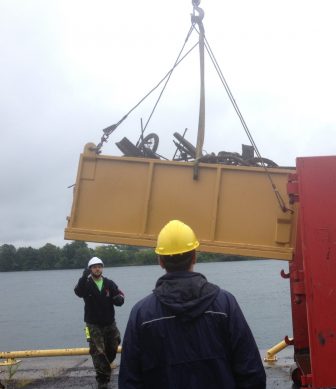
A diver removes garbage that could have been fish habitat. Image: Karen Cooper
By Becky Wildt
Replacing shopping carts with Christmas trees and rescuing vulnerable native mussels are among the recent attempts to restore habitat in the St. Lawrence River.
The river separates the cities of Massena, New York, and Cornwall, Ontario, and drains the Great Lakes to the Atlantic Ocean. The U.S. and Canada have listed this shared waterway as a Great Lakes Area of Concern (AOC). That means it is considered under the Great Lakes Water Quality Agreement as significantly environmentally damaged.
Grassroots efforts contribute to restoration aimed at removing the St. Lawrence and part of three tributaries from that binational list, experts say.
In Cornwall, the St. Lawrence River Institute of Environmental Sciences’ volunteer river cleanup program targets five locations with garbage on the shoreline and in the water. The initiative began after the public complained about shoreline litter.
“We went into the river with divers, anglers and volunteers and we removed about 12 tons of debris from the river,” said Karen Cooper, communications officer at the St. Lawrence River Institute. “There were about 85 kids from the Akwesasne Boys and Girls Club and they commented on how excited they were to be pulling this garbage off the shoreline and river.”
The debris hurts fish and wildlife, harms water quality and plants and obstructs

The river cleanup in Cornwall used mobile cranes to pull debris out of the water. Image: Karen Cooper
navigation, diving, swimming and other recreation, according to the institute. It also harms the economy and human health.
However, some of that trash had become valuable fish habitat.
“Even shopping carts were turning into habitat for fish,” Cooper said. “So when we removed the shopping cart, we know where we removed it from. What we’re going to be doing this year is use discarded Christmas trees and then in the spring, dump them into the river in areas where we pulled garbage up so fish will have a spawning ground,”
On the U.S side of the border at the St. Regis River, connected to the St. Lawrence, people relocated native mussels to aid habitat restoration after the obsolete Hogansburg Dam was removed this past summer.
Part of the St. Regis is considered part of the Area of Concern because of a history of industrial and municipal waste pollution similar to the St. Lawrence. However, the river was not used as a shipping waterway and has been spared the damage from invasive species that is seen in the St. Lawrence.
The St. Regis Mohawk Tribe Environmental Division’s environmental coordinator, Jessica Raspitha, said the Hogansburg Dam was the “first impassible barrier to fish from the St. Lawrence River and failed to meet state and tribal water quality standards. After the dam was removed, it opened up 274 river and stream miles for fish like walleye, muskellunge, Atlantic salmon, lake sturgeon and American eel.”
The tribe’s Environmental Division and 20 volunteers moved approximately 60,000 stranded mussels that were stuck on a four-mile length of shoreline. The group moved the mussels stranded on the beach when water levels receded.
“Mussels are an important part of the ecosystem,” Raspitha said. “They filter water, thereby improving water quality. They’re a food source to several culturally significant species, and the native population is facing a great deal of pressure from the presence of invasive species — zebra and quagga mussels.”

A map of the St. Lawrence River Area of Concern and its tributaries. Image: New York Department of Environmental Conservation
By placing the stranded mussels back into the water, they have a chance of survival and reproduction.
A recent study by the New York Department of Environmental Conservation and others compared the macroinvertebrate populations of Chironomus dilutus, a type of lake fly, in the St. Lawrence River to streams elsewhere. The survival of the lake flies in three of the four areas located in the Area of Concern did differ from the reference sites.
Historically the river was polluted with lead, copper and polychlorinated biphenyl (PCB) and other industrial discharges. But researchers said that habitat, rather than contaminated sediments, was a key driver of the survival of macroinvertebrate communities. Macroinvertebrates such as dragonflies and mayflies are commonly used to test the impact of these pollutants because of their inability to escape the contamination and because of their sensitivity to water quality.
The New York Department of Environmental Conservation plans to stabilize the shore and enhance spawning grounds, said press officer Jomo Miller.
Such projects have support from other groups. St. Lawrence River Institute officials plan to explain to the community the benefits of a natural shorelines over seawalls, Cooper said. Natural shorelines support habitat and the plants help clean the water.
That study also included researchers from the U.S. Geological Survey and the Saint Regis Mohawk Tribe. It appeared in the Journal of Great Lakes Research.
The only way to save and restore your precious ecosystem is by feeding it the way it had been fed for 12,000 years. Until you realize that ice boom theory answers your problems, you are whistling past the graveyard. The NYPA ice boom has stalled the natural ice conveyor which fed Lake Ontario and the entire st.Lawrence seaway. Google “Joe Barrett ice boom ” and learn the truth. Thx. JBB